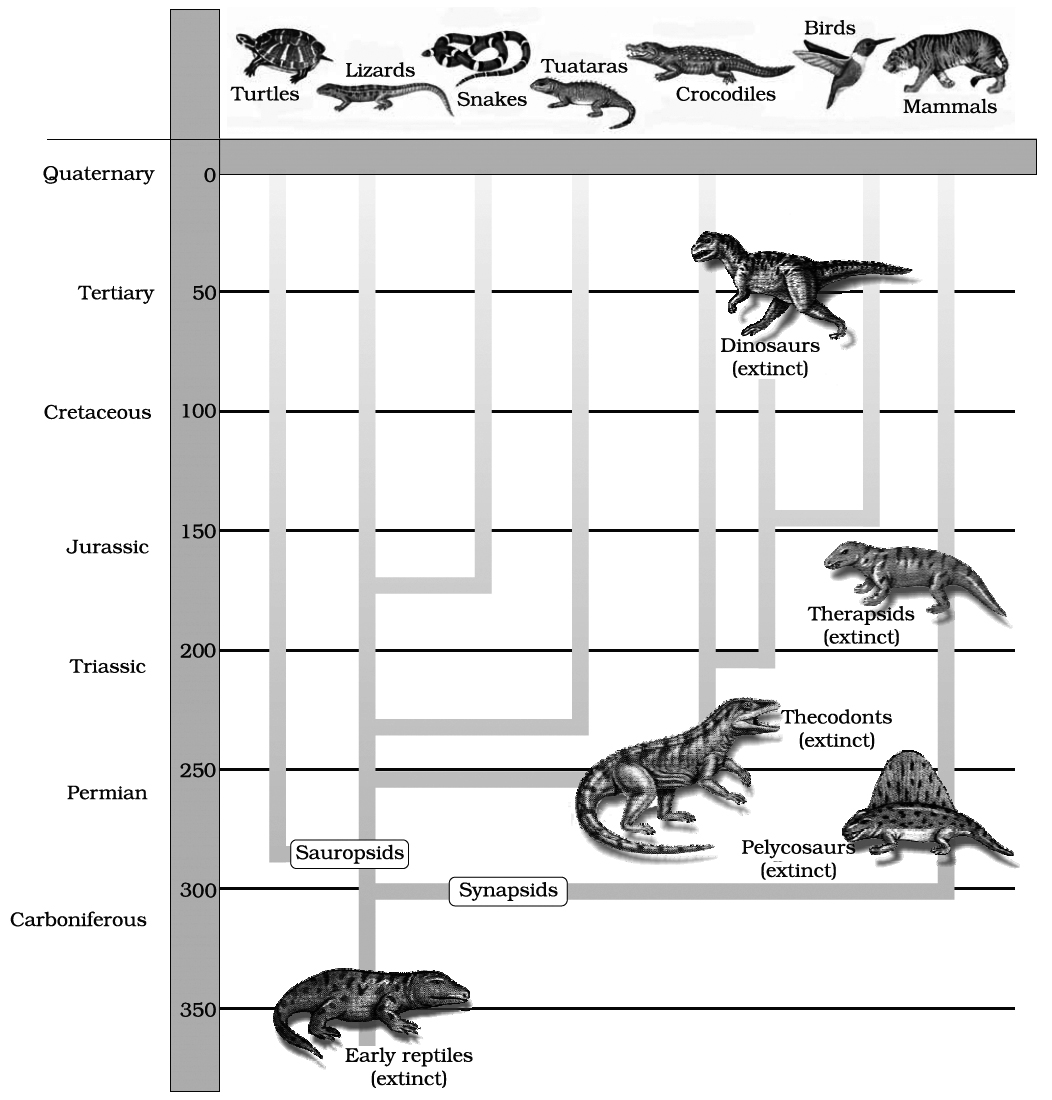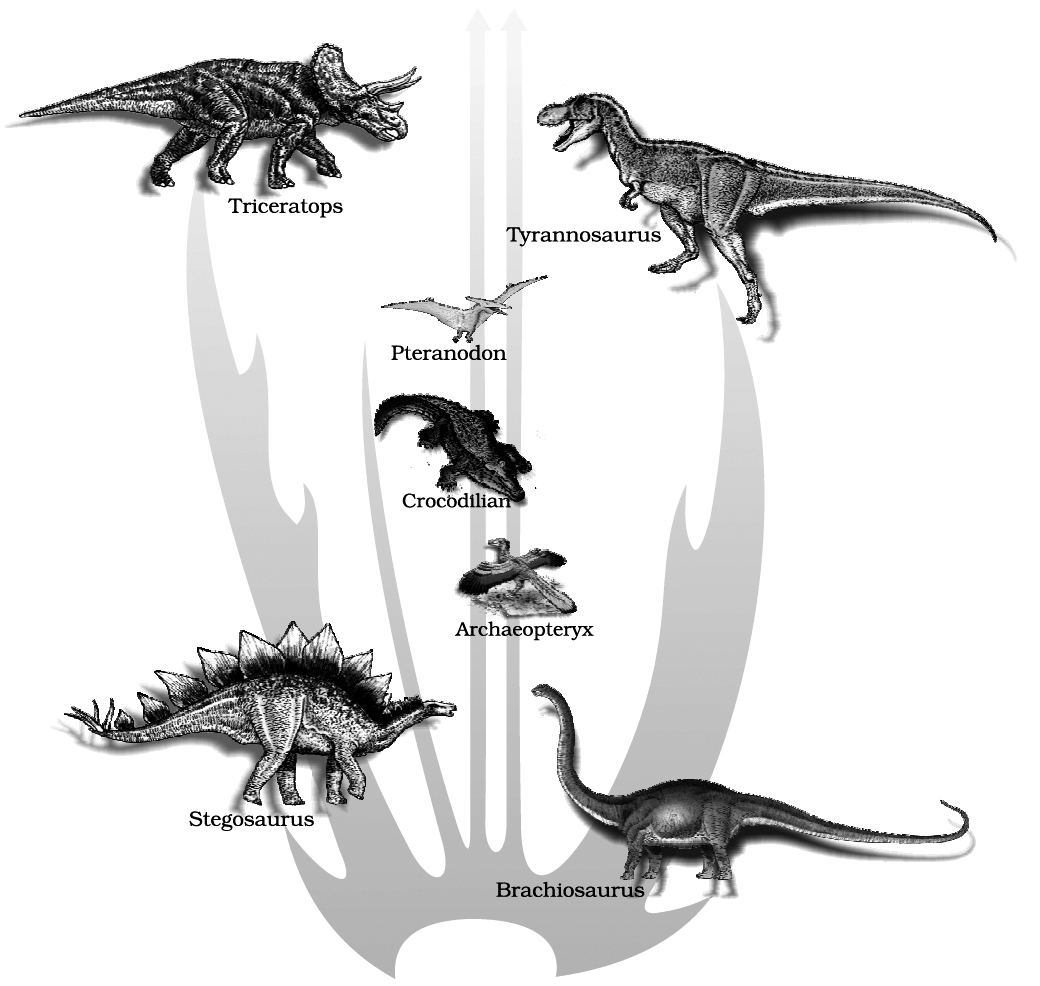- Books Name
- A TEXT OF BIOLOGY - CLASS XII
- Publication
- ACME SMART PUBLICATION
- Course
- CBSE Class 12
- Subject
- Biology
BRIEF ACCOUNT OF EVOLUTION
About 2000 million years ago (mya) the first cellular forms of life appeared on earth.
The mechanism of how non-cellular aggregates of giant macromolecules could evolve into cells with membranous envelop is not known.
Some of these cells had the ability to release O2.
The reaction could have been similar to the light reaction in photosynthesis where water is split with the help of solar energy captured and channelised by appropriate light harvesting pigments.
Slowly, single-celled organisms became multi-cellular life forms.
By the time of 500 mya, invertebrates were formed and active.
Jawless fishes probably evolved around 350 mya.
Sea weeds and few plants existed probably around 320 mya.
We are told that the first organisms that invaded land were plants.
They were widespread on land when animals invaded land.
Fish with stout and strong fins could move on land and go back to water.
There are no specimens of these left with us.
However, these were ancestors of modern day frogs and salamanders.
The amphibians evolved into reptiles.
They lay thickshelled eggs which do not dry up in sun unlike those of amphibians.
Again we only see their modern day descendents, the turtles, tortoises and crocodiles.

Representative evolutionary history of vertebrates through geological period
This was about 350 mya.
In 1938, a fish caught in South Africa happened to be a Coelacanth which was earlier thought to be extinct.
These animals called lobefins evolved into the first amphibians that lived on both land and water.
In the next 200 millions years or so, reptiles of different shapes and sizes dominated on earth.
Giant ferns (pteridophytes) were present but they all fell to form coal deposits slowly.
Some of these land reptiles went back into water to evolve into fish like reptiles probably 200 my a (e.g. Ichthyosaurs).
The land reptiles were, of course, the dinosaurs.
The biggest of them, i.e., Tyrannosaurus rex was about 20 feet in height and had huge fearsome dagger like teeth.
About 65 mya, the dinosaurs suddenly disappeared from the earth.
We, do not know the true reason. Some say climatic changes killed them.
Some say most of them evolved into birds.

A family tree of dinosaurs and their living
modern day counterpart organisms like crocodiles and birds
The truth may live in between.
Small sized reptiles of that era still exist today.
The first mammals were like shrews.
Their fossils are small sized.
Mammals were viviparous and protected their unborn young inside the mother's body.
Mammals were more intelligent in sensing and avoiding danger at least.
When reptiles came down mammals took over this earth.
There were in South America mammals resembling horse, hippopotamus, bear, rabbit, etc.
Due to continental drift, when South America joined North America, these animals were over ridden by North American fauna.
Due to the same continental drift, pouched mammals of Australia survived because of lack of competition from any other mammal.
Lets we forget, some mammals live wholly in water.
Whales, dolphins, seals and sea cows are some examples.
Evolution of horse, elephant, dog, etc., are special stories of evolution.
You will learn about these in higher classes.
The most successful story is the evolution of man with language skills and self-consciousness.
THEORIES OF EVOLUTION
1. LAMARCK'S THEORY OF EVOLUTION
His theory is often called as the Theory of Inheritance of Acquired Characters or the Theory of Use and Disuse of Organ.
The first attempt to explain origin of species and their adaptation to the environment was done by Jean Baptiste Lamarck (1744-1829).
He was the greatest French naturalist.
Lamarck's theory was published in 1809 (year of Darwin 's birth) in his book 'Philosophie Zoologique'.
According to this theory the organisms undergo changes to adapt themselves to the environment.
The changes acquired by the organisms during their life time are passed on to the next generation.
He took the example of long neck of Giraffe, they continuously stretched their neck to reach to the vegetation on trees.
This acquired change was passed to the next generation.
He also gave the principle of Use and Disuse.
Use of an organ leads to strengthening of the organ, and disuse will lead to weakening of the organ.
Lamarck arranged his theory in the form of four postulates.
(i) Internal forces tend to increase size of the body.
(ii) Formation of new organs is the result of the need or want continuously felt by organisms Doctrine of Appetency/Desires.
(iii) Development and power of action of an organ is directly proportional to its use.
(iv) All changes acquired by the organism during its life are transmitted to the offsprings by the process of inheritance.
Concept Builder
Lamarck's theory was discarded by A. Weismann who gave the Theory of Germplasm.
He cut the tail of new born mice generation after generation but could not get tailless mice nor the mice developed shorter and shorter tail.
Today, again the faith in Lamarck's theory has been revived as it is said that if the environment influences the genes of the organisms, the acquired change will be transmitted to the next generation.
2. DARWIN'S THEORY OF EVOLUTION
Charles Robert Darwin put forward the concept of natural selection as the mechanism of evolution.
The theory was put forward along with Alfred Russell Wallace.
Darwin had written the book 'Origin of Species'.
Darwin was greatly influenced by 'An Essay on Population' written by Thomas Rev Malthus and he was also influenced by Charles Lyell's essays on "Principles of Geology".
Darwin was a British naturalist.
In 1831, at the age of 22, he was appointed upon a world survey ship of British government, H.M.S. Beagle.
For five years on his ship, Darwin explored the fauna and flora of continents and islands.
Branching descent and Natural Selection are the two key concepts of Darwinian Theory of Evolution.
According to Wallace's Chart, the main points of Darwin's theory of Natural Selection were as follows:
(i) High rate of reproduction
(ii) Total number almost constant
(iii) Struggle for existence
(iv) Variations
(v) Survival of fittest
(vi) Natural selection
All the successful organisms have a high Biotic Potential or Reproductive Rate.
The organisms produce a large number of offsprings that can possibly survive, example a mice produces a dozen of mice at one time.
A rabbit produces 6 young ones in a litter and there are four litter in a year.
A rabbit starts reproducing at the age of six months.
1. Not all but only some individuals which survive, reach adulthood, and those which reach adulthood, reproduce at different rates, this is called 'Differential Reproduction'.
2. The success in survival and reproduction depends upon the characteristic traits of an organism, example only those rabbits will survive which are fastest. There is 'Struggle for Existence' and in this there will be 'Survival of Fittest'. The Phrase 'Survival of Fittest' was first used by Herbert Spencer. The same context was asserted by Darwin as 'Natural Selection'.
So, evolution is the change in the genetic composition of the population which is brought about by natural selection which acts upon the variability in population.
Causes of Variations
1. Mutation is the ultimate source of variations.
2. At the next level is recombination .
3. Intermingling of two widely separated populations.
Weakness of Darwinism
He was not able to explain the cause of discontinuous variations observed by himself in nature and the mode of transmission of variants to the next generation.
In 1868, Darwin put forward the Theory of Pangenesis.
According to this theory, every organ of the body produces minute hereditary particles, called Pangenes or Gemmules and they are carried through the blood into the gametes.
Weismann's 'Theory of Germplasm' (1892) rejected Darwin's theory of pangenesis.
He established that the germ (sex), cells are set apart from other body (somatic) cells early in the embryonic development, so, only the changes in the germplasm affect the characteristics of future generations.
Alfred Wallace had written the book 'On the Tendencies of Varieties to Depart Indefinitely from the Original Type'.
Alfred Wallace (1823-1923), a naturalist from Dutch East Indies, was working on Malay Archipelago (present Indonesia).
Concept Builder
Erasmus Darwin :
Charles Darwin's grandfather, Erasmus Darwin, wrote about evolution more than 60 years before his grandson's theory was presented.
Erasmus Darwin cited things such as the metamorphosis of insects, the new varieties produced by selective breeding, the variations among similar organisms in different climates, and the similarities of vertebrate structure as evidence that all life was "produced from a similar living filament".
3. MUTATION THEORY
In 1901, Hugo de Vries proposed the Mutation Theory on the basis of his observation on the wild variety of evening primrose Oenothera lamarckiana.
According to mutation theory, new species originate as a result of large, discontinuous variations which appear suddenly.
The main features of mutation theory are as follows :
1. Mutations arise from time to time amongst the individuals of a naturally breeding population.
2. Mutations are heritable and establish new forms or species.
3. Mutations are large and sudden and are totally different from fluctuating variations of Darwin, which are small and directional.
4. Mutations may occur in any direction.

 ACME SMART PUBLICATION
ACME SMART PUBLICATION
